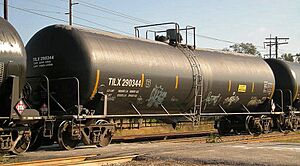Bulk cargo facts for kids

Bulk cargo is a type of goods that are carried in very large amounts without being packaged. Think of it like a giant pile of something, rather than many small boxes. This way of moving goods is super important for industries all over the world.
Bulk cargo can be many different things, like gases, liquids, coal, wheat, iron ore, or even sand and gravel. These materials are often raw materials, which means they are used to make other products or to create energy.
Contents
What is Bulk Cargo?
Bulk cargo refers to materials that are transported in large, unpackaged quantities. They are usually poured or loaded directly into a ship's hold, a train car, or a truck. This method is very efficient for moving huge volumes of materials that are not sensitive to being handled loosely.
Why is Bulk Cargo Important?
Moving goods in bulk is a big deal for the global economy. It allows factories to get the raw materials they need to make products, and it helps countries get the energy they need. For example, iron ore is moved in bulk to make steel, and grain is moved in bulk to make food. Without bulk cargo transport, many everyday items would be much harder to produce or would cost a lot more.
Types of Bulk Cargo
Bulk cargo can be divided into two main types: dry bulk and liquid bulk.
Dry Bulk Cargo
Dry bulk cargo includes solid materials that are not packaged. They are usually in the form of powders, granules, or larger pieces.
- Grains: Things like wheat, corn, rice, and soybeans are often shipped in bulk to feed people and animals around the world.
- Ores and Minerals: This includes iron ore (used for steel), bauxite (used for aluminum), and various other minerals.
- Coal: A major source of energy, coal is transported in huge amounts to power plants.
- Cement and Aggregates: Materials like cement, sand, and gravel are crucial for building roads and buildings.
- Fertilizers: Used in agriculture to help crops grow, fertilizers are also moved in bulk.
Liquid Bulk Cargo
Liquid bulk cargo refers to liquids or gases that are transported in large tanks.
- Oil and Petroleum Products: Crude oil, gasoline, and diesel are some of the most common liquid bulk cargoes, moved by oil tankers and pipelines.
- Chemicals: Many industrial chemicals, like acids and solvents, are transported in bulk.
- Liquefied Natural Gas (LNG): Natural gas is cooled down to a liquid state so it can be shipped across oceans in special tankers.
- Edible Oils: Oils used for cooking, like palm oil or sunflower oil, are also moved in bulk.
How Bulk Cargo is Transported
Bulk cargo is moved using specialized vehicles and vessels designed to carry large, unpackaged loads.
By Sea
Large bulk carrier ships are the most common way to move dry bulk cargo across oceans. These ships have huge holds that can carry hundreds of thousands of tons of material. For liquid bulk, tanker ships are used. Some tankers are so big they can carry enough oil to fill many Olympic-sized swimming pools.
By Rail
Trains use special cars called hopper cars for dry bulk cargo, which can be open-topped or covered. For liquids and gases, tank cars are used. Trains are very efficient for moving bulk cargo over long distances on land.
By Road
Trucks with open trailers or tanker trucks are used for shorter distances, often to move bulk cargo from ports or rail yards to factories or local distributors.
By Pipeline
For liquids and gases like oil and natural gas, pipelines are a very efficient way to transport them continuously over very long distances, even across continents.
Loading and Unloading Bulk Cargo
Loading and unloading bulk cargo requires special equipment. At ports, huge cranes, conveyor belts, and specialized machines called "grabbers" are used to move materials quickly. For liquids, powerful pumps transfer the cargo into and out of tanks. These operations are carefully planned to be safe and efficient, making sure the materials get to where they need to go without waste.
Images for kids
See also
 In Spanish: Carga a granel para niños
In Spanish: Carga a granel para niños







